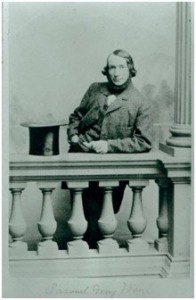
Several authors count Samuel Gray Ward’s (1817-1907) purchase in 1844 of the original Highwood as the beginning of Lenox as a resort community. Ward certainly set the mold for others who would follow shortly. He was the son of Thomas Ward who sought out investment opportunities in the burgeoning American economy for London based Barings Bank.
Young Samuel was a member of Emerson’s circle (a Transcendentalist Groupie?) and he longed to pursue the life of a country scholar.
Time Was Right for an Early Summer Resort
But to understand how this act set off a bit of a ripple of grand summer homes, we should probably consider how the stage was set as New England rolled into the new century.
- The economy was shifting from agricultural subsistence to a cash based economy with the emergence of wage labor, professional services and trade as increasingly important — particularly in the Northeast. A mobil wealthy class was emerging.
- Other areas – particularly the Northwest Territories and Upstate New York offered better agricultural opportunities than New England. Starting as early as 1790 with Major General John Paterson moving to upstate New York, the phenomenon of investing in land for its economic potential was shifting away from New England. The quality was better and there wasn’t much open land left in Massachusetts
- Population density (in the 1830-1850 censes Massachusetts had one of the highest densities per square mile) motivated those who were able to seek the health and beauty of the countryside.
- Transportation improvements were accelerating allowing more people to go where they wanted to go and allowing economic specialization (i.e., wheat from the midwest, dairy and fresh food from New England moved to cities). Roads had improved steadily since the Revolution and even before rail service was established, there was regular coach service stopping at what would become the Curtis Hotel. Then several major developments occurred 1820-1850. The completion of the Erie Canal in 1825 eased east west transport through the Great Lakes. The railroad came to Berkshire County by 1841 providing relatively easy access to the countryside for movers and shakers from Boston and New York.
- America was just beginning to define its own art and culture and patronage and discussion were eagerly sought by the elite. Between the courts, the Sedgwicks, and the schools there apparently was enough critical mass to attract a steady flow of artists and literati such as Nathaniel Hawthorne, Herman Melville and Thomas Cole.
Highwood

Samuel Ward purchased land from farmer Daniel Barnes’ farm – selected for its beautiful view of the Stockbridge Bowl. Although their home was famously chilly, the Wards lived year round at Highwood from 1845 to 1849 and quickly merged with the Sedgwick cultural circle for teas, talks, recitations and concerts. The original Highwood (the one shown above had been considerably altered) was designed by Richard Upjohn who was, at the time, also working on Trinity Church in New York. Although the country intellectualism of the Wards and the Sedgwicks was much less pretentious than other what would follow later in the century, the trend of out of town architects and conscious design had begun.

The couple attracted other Boston visitors and, when Sam was forced to return to Boston to take over his father’s business he rented Highwood to the Tappans who would eventually take up residency on what is now part of the grounds of Tanglewood. In 1850 they rented the little red house at the end of the drive to Nathaniel Hawthorne and his family.
Afterward
Eventually, Highwood was sold to another successful Boston businessman, William S. Bullard. When the property was turned over to the Boston Symphony Orchestra mid twentieth century,

The Wards had never cut their ties to Lenox and when Sam Ward retired in the 1870’s he purchased a property near Highwood and had Charles McKim build shingle style Oakwood in 1876. In 1891, the property was sold to Anson and Helen Stokes who would build Shadow Brook up the hill and convert Oakwoods to a stable. It burned in 1903.
So here was another pattern of tearing down charming existing homes to put up bigger, grander “cottages.”
For much more information on the early days of Lenox as a summer resort see, The Tanglewood Circle, Hawthorne’s Lenox, by Cornelia Brooke Gilder with Julia Conklin Peters
